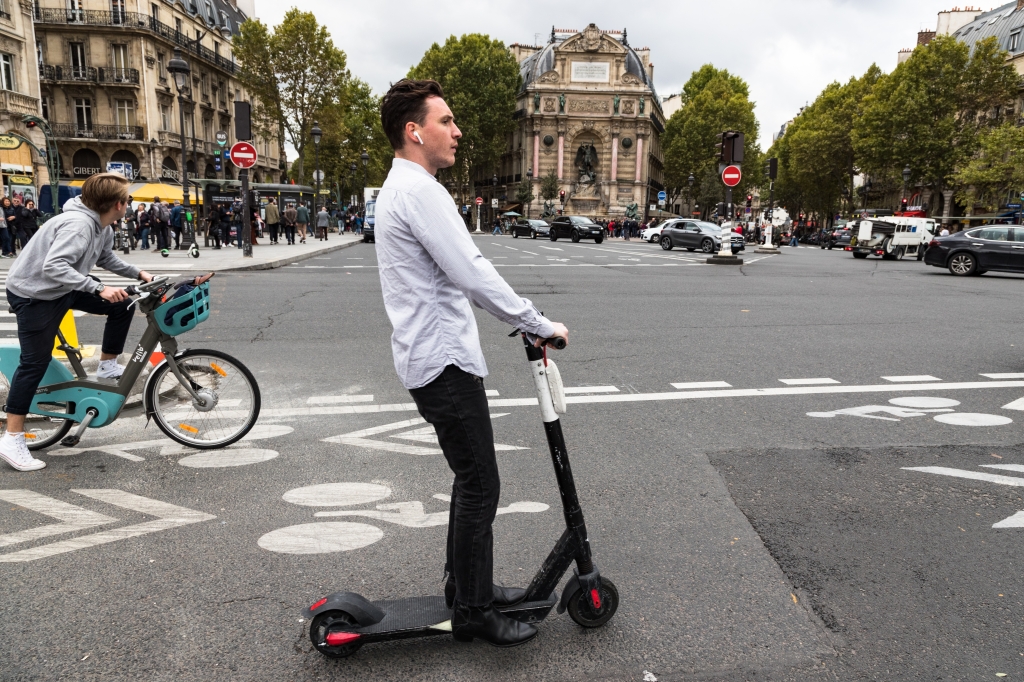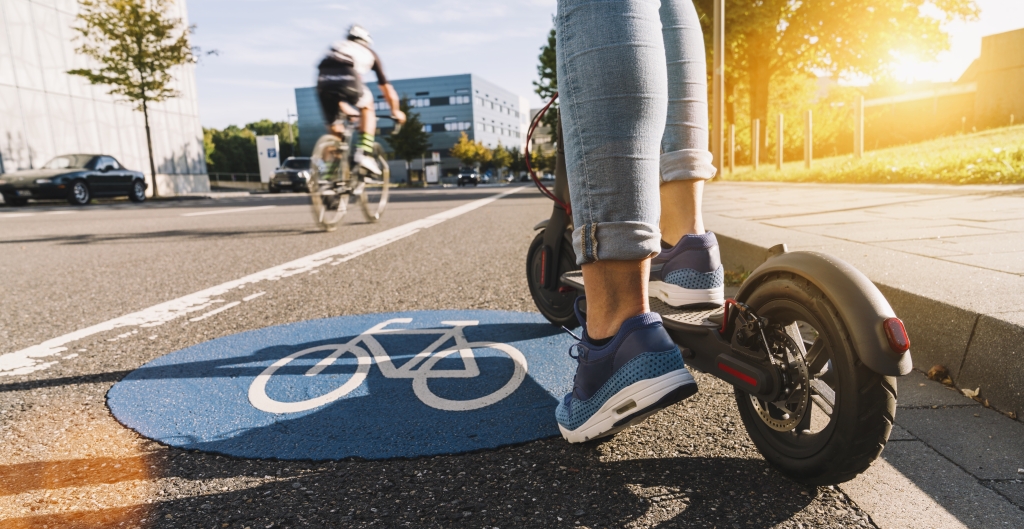The shared e-scooters floating around Paris may have emitted 12 000 tonnes of additional greenhouse gases over the course of one year, according to a new study. Are the popular micro-vehicles good fun, but not good for the climate?
by Anne de Bortoli

The sudden arrival of massive numbers of shared electric scooters in many cities around the world since 2017 has triggered considerable resentment from other users of our urban space. The skepticism is shared by governments and local authorities – some of whom have banned e-scooters outright, as is the case in London and many university campuses in the United States.
Others have targeted e-scooters with specific regulations. France added a new section to the Code de la route that covers motorised micro-vehicles. The city of Paris will allow only three selected companies to operate in the city, which will be partly chosen on environmental criteria.
But assessing the hoped-for environmental benefits of e-scooters turned out to be a headache for public authorities. The first scientific assessment was not published until the summer of 2019 and was too narrow to draw general conclusions about their environmental effect: it only estimated the environmental impact of using a free-floating e-scooter over an average of one kilometre in US cities.
Change to the system
Yet e-scooters are disrupting the long-established patterns of urban mobility and should not be looked at in isolation. They are not just something additional, they are bringing real change to the system: by replacing trips with cars, bicycles or on foot, but also by inducing people to take an e-scooter when previously they would not have bothered to move.
The environmental question, therefore, should be addressed in these terms: have shared e-scooters reduced the overall environmental impact of human mobility so far? If the answer is yes, how can we exploit these benefits even further? If it is no, should there be any room for e-scooters in a sustainable mobility system?
What’s in a lifetime?
At the University of Patras, we took up the challenge. Using a cutting-edge method developed in-house, we were able to calculate how CO2 and other greenhouse gas emissions for the entire mobility system of Paris over a whole year were affected by the usage of shared e-scooters

The model reflects how people switch from other transport options to shared e-scooters as well as the new trips these trigger, information that was gleaned from a dedicated survey. It also uses a so-called life cycle assessment, which takes account not only of direct emissions during operation but the entirety of emissions over the life cycle of the elements that make up the transport system, including infrastructure and vehicles.
This is crucial. The operation of shared vehicles is comparatively energy efficient, and much of the environmental impact stems from manufacturing, maintenance, and disposal. The model also anticipates changes that are likely to occur in relevant industries – for instance a change in the carbon intensity of the electricity consumed – to calculate environmental performance.
In the (carbon) balance
The result of the modelling exercise was perhaps unexpected: Parisian e-scooters (shared ones, that is) generated 12 000 tonnes of additional greenhouse gases in the city over one year ─ that is equivalent to the annual emissions produced by a French town of 15 000 inhabitants.
Three reasons lie behind this negative carbon balance.
First, the production of e-scooters is not very environmentally-friendly. Production accounts for a full third of the Parisian e-scooters’ marginal environmental impact, that is to say of the absolute values of the GHG savings and extra-emissions due to shared e-scooters. This is notably due to the carbon-intensive production of the aluminum used for the vehicle frame and because of the lithium-ion battery.
Second, servicing the e-scooters causes considerable emissions. Standard vans with internal combustion engines are used to collect the e-scooters, charge them and then drop them again across the city. This support also makes up one third of the Parisian e-scooters’ marginal emissions due to shared e-scooters.
Finally, e-scooter trips often replace low-carbon trips. This is due to 60% of modal shifts coming from massive electrified public transport – the Metro, the RER light trains, the trams, 13% from walking, and 9% from cycling. These transport modes present a lower carbon footprint than the shared e-scooter: respectively 8, 9, 20, 2 and 36 gCO2eq per passenger-kilometre traveled, compared to 108 g for the e-scooter.

Strike ‘em?
So should e-scooters be struck from the list of solutions for green mobility? In fact, things are not quite that simple. Their environmental impact depends on three factors: firstly, their entire life cycle emissions (and how operators manage these), the specific mobility patterns of the cities in which they operate (and the shares of transport modes e-scooters replace); and, finally, the carbon intensity of the electricity they consume.
The carbon footprint for a shared e-scooter roaming Paris is 50 grams of CO2eq per kilometre, if servicing impacts are excluded – which is about as much as that of a shared bicycle. And if the e-scooter’s lifetime mileage increases to 5 200 kilometres instead of 3 750 (our base case scenario in the model), the emissions fall to 30 gCO2eq per kilometre traveled: in Paris, this is one quarter of a diesel bus, one seventh of a private car, and one tenth of a taxi’s emissions per passenger-kilometre traveled.
Operators thus have their work cut out: they need to simultaneously green manufacture of e-scooters, improve their durability and recyclability, and drastically enhance their servicing process. In the case of Paris, the last point is necessary to get a positive impact of the shared e-scooters.

Each city has a unique mobility system with specific environmental impacts and different user behaviors, and these factors shape the impact e-scooters have on the overall system. The results of our analysis thus cannot be simply transferred to other cities, and even less to other countries. But an extra analysis we did on the impact of the electricity carbon intensity does suggest that, beyond the case of Paris or similar cities, shared e-scooters have a good potential to make urban mobility greener, once the three main factors that make their current carbon balance negative – at least in Paris – have been addressed. Whether that promise materialises in different contexts will need to be examined in well-tailored, case-by-case studies.
Watch the life cycle
What are our conclusions and recommendations? First, the environmental performance of transport options must be assessed for the complete life cycle to ensure shared vehicles are really green(er). Conventional wisdom assumes that using more shared vehicles reduces the environmental footprint, but our somewhat counter-intuitive results show that servicing and shorter lifespans can in fact lead to higher overall emissions.
Secondly, proper assessments of transport modes needs (good) data. Operators should therefore be required, as a licensing condition, to share their data with the public authorities ─ vehicle components and energy consumption, as well as statistics on servicing, lifetime mileage, maintenance schemes and recycling. For our study, we contacted the thirteen e-scooter operators in Paris in the summer of 2019 ─ only one answered, and finally did not share any data.
Finally, e-scooters and other micro-vehicles have a role to play in a green mobility system ─ even where their eco-balance is less good than other modes. E-scooters can help overcome the first/last mile problem that keeps many people from using public transport because the closest metro station is too far to walk to.
The availability of shared e-scooters can also trigger a ripple effect: the experience could nudge people to buy their own personal e-scooter, which will likely be used much longer and thus with a much lower life cycle emissions ─ we estimate them as low as 12 gCO2eq/km for a life-cycle use of 15 000 km.
Let’s not forget that mobility systems are dynamic. Thus, environmental assessments need to be updated regularly, especially when new services enter the mix and change somewhat established patterns. And it is a safe bet that the current pandemic is changing mobility habits drastically, possibly for good.
Anne de Bortoli is the ITF Young Researcher of the Year 2020. This blog summarises the findings of her winning paper, which she wrote while at the University of Patras, Greece, and currently under peer review for an international journal. Anne is now an eco-design researcher with Eurovia, the road construction subsidiary of the VINCI Group.